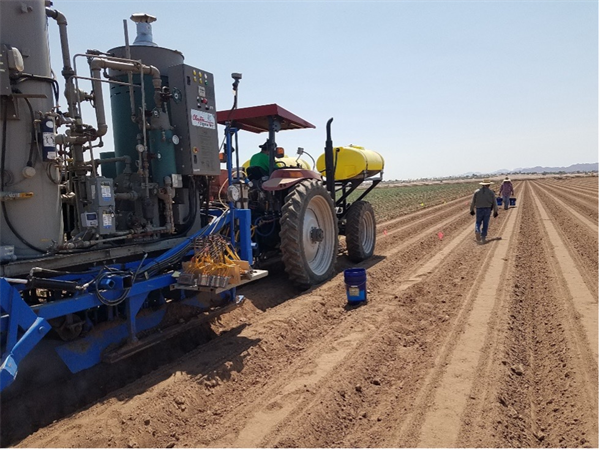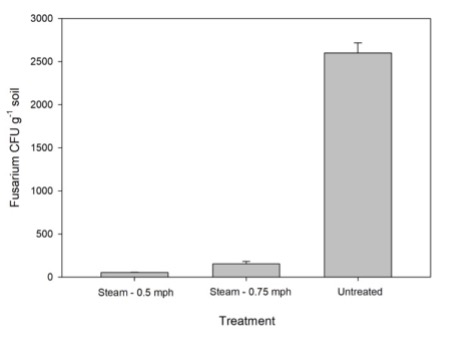Yesterday, we initiated our first trial of the season examining the use of band-steam for controlling Fusarium wilt of lettuce. The premise behind this research is to use steam heat to raise soil temperatures to levels sufficient to kill soilborne pathogens. For Fusarium oxysporum f. sp. lactucae, the pathogen which causes Fusarium wilt of lettuce, the required temperature for control is generally taken to be > 140°F for 20 minutes.
In our multi-year study, we are using a 35 BHP steam generator mounted on a custom designed elongated bed shaper to inject steam in the soil (Fig. 1). Trials conducted last fall show the technique holds promise. Fusarium colony forming units (CFU) were reduced from 2,600 in the control to 155 in the 0.75 mph travel speed and 53 in the 0.5 mph travel speed treatments, respectively (Fig. 2).
Fusarium load at the site where this week’s trial was conducted is reportedly high and we’re looking forward to obtaining good results. We’re also planning a second trial later this month at the Yuma Ag Center that is also focused on Fusarium wilt of lettuce control.
Stay tuned for results of all our trials examining the efficacy of using steam heat to control Fusarium wilt of lettuce, sclerotinia lettuce drop, pythium and weeds.
As always, if you are interested in seeing the machine operate or would like more information, please contact me.
Acknowledgements
This project is sponsored by USDA-NIFA and the Arizona Specialty Crop Block Grant Program. We greatly appreciate their support. A special thank you is extended to Larry Ott and Gila Valley Farms for allowing us to conduct this research on their farm. Fig. 1. Prototype band-steam applicator/bed shaper operating in Wellton, AZ. Fig. 2. Effect of band-steam applied at two travel speeds on Fusarium colony forming units (CFU) in the soil.

Fig. 1. Prototype band-steam applicator/bed shaper operating in Wellton, AZ.

Fig. 2. Effect of band-steam applied at two travel speeds on Fusarium colony
forming units (CFU) in the soil.





